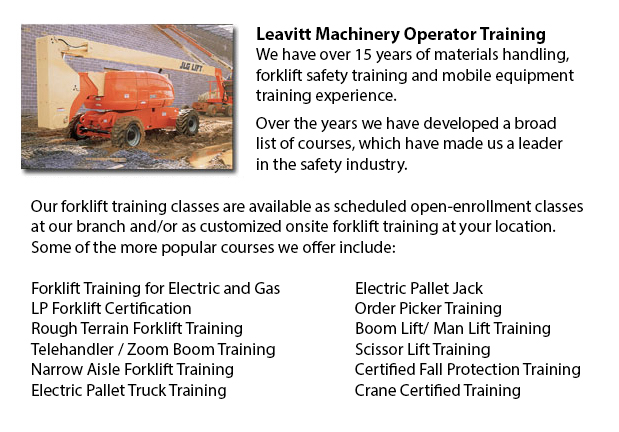
Aerial Platform Training Kamloops - Aerial forklifts might be utilized to accomplish several different duties executed in hard to reach aerial places. A few of the tasks associated with this style of lift include performing routine maintenance on structures with elevated ceilings, repairing telephone and power cables, raising heavy shelving units, and pruning tree branches. A ladder could also be utilized for some of the aforementioned tasks, although aerial platform lifts provide more security and strength when correctly used.
There are a number of different types of aerial lifts existing, each being able to perform moderately unique tasks. Painters will usually use a scissor lift platform, which is able to be used to get in touch with the 2nd story of buildings. The scissor aerial jacks use criss-cross braces to stretch out and extend upwards. There is a platform attached to the top of the braces that rises simultaneously as the criss-cross braces elevate.
Container trucks and cherry pickers are a different type of aerial hoist. They contain a bucket platform on top of an extended arm. As this arm unfolds, the attached platform rises. Lift trucks utilize a pronged arm that rises upwards as the lever is moved. Boom lift trucks have a hydraulic arm that extends outward and elevates the platform. All of these aerial lift trucks require special training to operate.
Through the Occupational Safety & Health Association, also labeled OSHA, training courses are offered to help ensure the workers meet occupational standards for safety, machine operation, inspection and maintenance and machine load capacities. Workers receive qualifications upon completion of the course and only OSHA qualified workers should drive aerial platform lifts. The Occupational Safety & Health Organization has developed rules to uphold safety and prevent injury when using aerial lifts. Common sense rules such as not utilizing this piece of equipment to give rides and making sure all tires on aerial hoists are braced so as to hinder machine tipping are noted within the guidelines.
Unfortunately, statistics expose that more than 20 aerial hoist operators die each year while operating and almost ten percent of those are commercial painters. The bulk of these mishaps were triggered by inadequate tie bracing, for that reason a few of these may well have been prevented. Operators should ensure that all wheels are locked and braces as a critical safety precaution to stop the instrument from toppling over.
Marking the encompassing area with obvious markers have to be used to protect would-be passers-by in order that they do not come near the lift. Moreover, markings must be set at about 10 feet of clearance between any electrical lines and the aerial lift. Hoist operators should at all times be properly harnessed to the lift while up in the air.
-
Forklift Training Course Kamloops
Forklift Training Course Kamloops - CSA and OSHA establish criteria for forklift safety training that meets current standards and regulations. Anybody planning to use a forklift is needed to successfully complete safety training prior to utilizing an... More -
Forklift Training Program Kamloops
Forklift Training Program Kamloops - The forklift is a common powered industrial vehicle which is in wide use these days. They are occasionally called lift trucks, jitneys or hi los. A departments store will use the forklift in order to unload and lo... More -
Aerial Lift Training Kamloops
Aerial Lift Training Kamloops - The mechanized access platform known as an aerial work platform is a machinery which provides access to places that are otherwise inaccessible to people and other machine. Likewise called an elevating work platform or... More -
Forklift Training School Kamloops
Forklift Training School Kamloops - Forklift Training School - CSA and OSHA establish criteria for forklift safety training which meets existing standards and regulations. Anybody planning to use a forklift is needed to successfully complete safety t... More -
Heavy Equipment Training Courses Kamloops
Heavy Equipment Training Courses Kamloops - When choosing a heavy equipment operator course, the initial step must be to determine the capacity in which you would be working with heavy machines. You could find the correct course to teach you how to o... More -
Heavy Equipment Training School Kamloops
Heavy Equipment Training School Kamloops - HEO or also known as the heavy equipment operator courses would provide you with the skills and knowledge required in order to enter the workforce as an entry level heavy machine operator. In this 12 week co... More -
Telehandler Operator Training Kamloops
Telehandler Operator Training Kamloops - Telescopic handler Forklifts or telehandler forklifts are common industrial equipment found in numerous construction industry environment. The telehandler is a helpful machinery and makes for a valuable tool w... More -
Telehandler License Kamloops
Telehandler License Kamloops - A telehandler or telescopic handler is a machine which is frequently utilized in agricultural and industrial applications. It has a similar appearance to a forklift and even works in a similar manner, though, the teleha... More

Forklift Training Kamloops
TOLL FREE: 1-888-254-6157
Kamloops, British Columbia
forklifttrainingkamloops.com
Email Us
About Us


